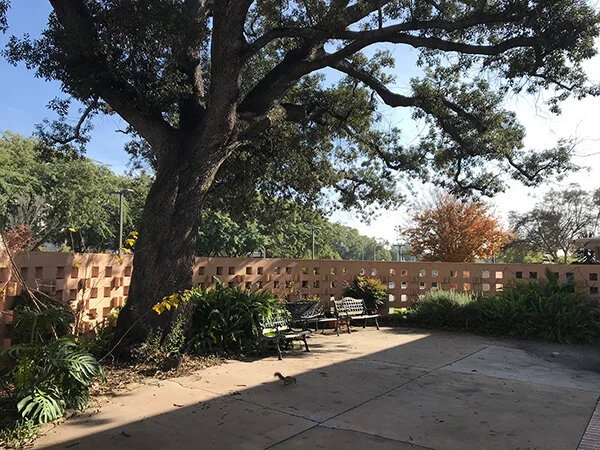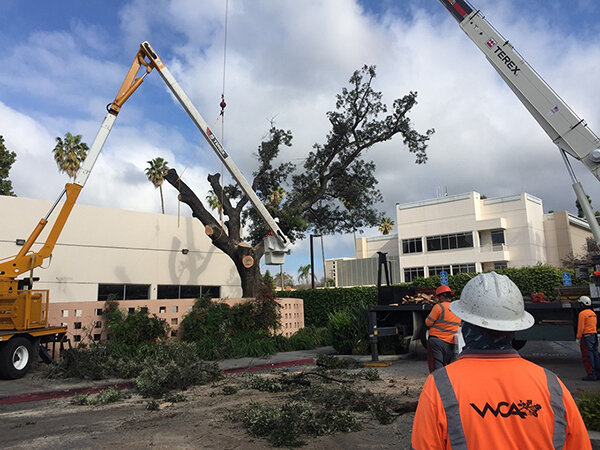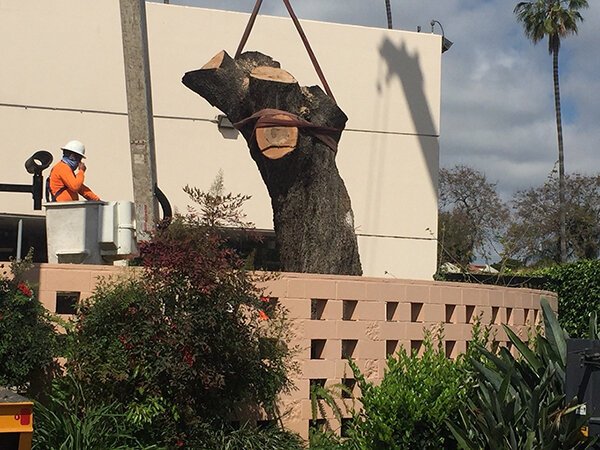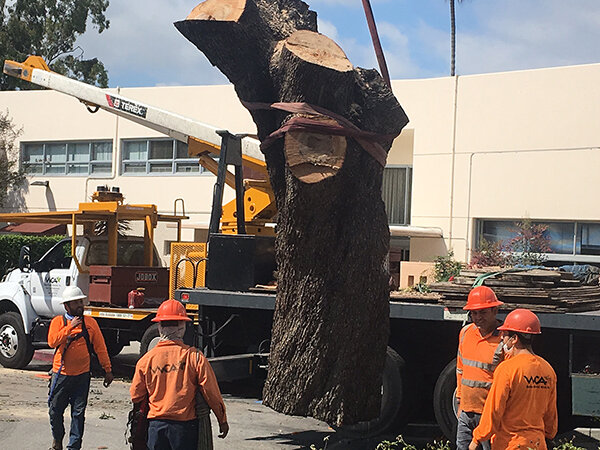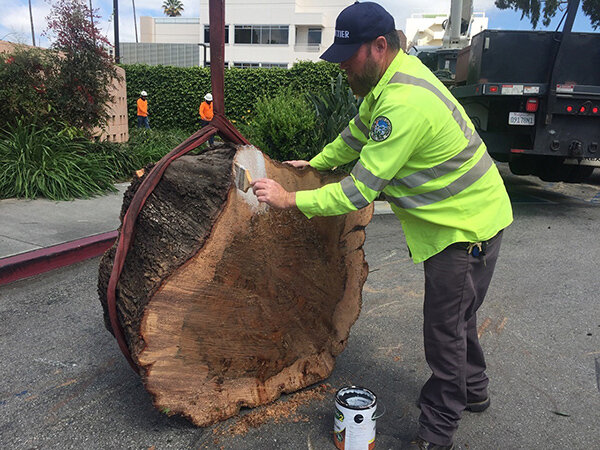Thank you, neighbors, for attending the City Council Meeting Tues, Jan. 23rd.
Showing up in person to voice your concerns over current council actions is how government is meant to operate. When we don’t put our words into action, we can get steamrolled. Everyone was articulate and passionate and demonstrated that citizens matter.
We will continue to keep you apprised of the issues as they stand and as they unfold. We must all stay focused on what we, the citizens want, rather than letting city hall foist their agenda upon us. Please continue to communicate with your city council.
—————————————————————The “Uptown Streetscape Plan” was approved by the City Council on December 12, 2013 in final form.
The project was supposed to be an “amendment” to the approved plan of 2019, which called for the removal of 12 trees. The removal of ALL of the trees was mentioned for the first time at the December meeting as necessary to achieve the plan’s other goals: outdoor dining, street paving, pocket park, lighting, umbrellas, etc.
Current Tree Protection law requires the assessment of EACH TREE individually, to address viability and potential hazards. This was not done. The mandate by the Public Works Dept. to remove ALL of the trees at one time, without regard for the environmental consequences, is a violation of the Tree Ordinance and a violation of California law.
The cost to the taxpayers has jumped from $3.5 million to over $20 million with the addition of the mandate to remove all trees and regrade the street. With citizen input, we believe the City can implement the project on a more human scale—without such a severe impact—by removing trees over time, incrementally, which is already required by city law.
Public input is an essential component of decision-making that will impact our quality of life for generations to come.
The city is now trying to water down the Tree Protection Ordinance to facilitate this project and others.
Promenade Project Facts
For months now, the City has been telling you that the cost of its liability insurance is linked to tree protection. This is a misleading attempt to chip away at the Tree Protection Ordinance by associating tree policies with risk management. Gutting the Tree Manual will not reduce the city’s insurance costs.
ONCE —in the span of 133 years— an accident occurred resulting in a large insurance settlement. That unfortunate incident should not be used to justify watering down the protections for our Urban Forest.
The residents of Whittier fought hard for the ordinance and want it to be respected and enforced, not diminished as a convenience to the Public Works Dept.
The attempt to move tree oversight from the Parks Dept. to Public Works, to facilitate development projects, and to limit the public’s ability to appeal is simply wrong. Creating a “Justified Tree Removal Committee” is one more step toward diminishing public participation.
1. We have a Tree Protection Ordinance for a reason: to protect our urban forest. The Promenade Plan violates the Tree Ordinance by not evaluating each tree individually—as legally required—to assess its condition and vitality. The notion that ALL the trees have to go is just absurd.
2. No mitigation has even been attempted that would offset the loss of over 100 trees and the oxygen they generate for our health and well-being. Each mature tree absorbs approximately 50 lbs. of carbon per year, enough to provide for a family of four. Your tree “replacement” will take decades to compensate for this loss at a time when it is most needed. Construction alone will take years and businesses will suffer greatly under those conditions.
3. Los Angeles now requires a ratio of almost 4 to 1 in tree replacement in order to offset canopy loss and carbon sequestration. This could be achieved by planting a series of trees on adjacent residential streets in Uptown that are now barren, hot, and treeless.
In light of all of this information, we ask that the city reconsider it’s approval of the Promenade Project, until adequate provisions of the Tree Ordinance have been implemented the way they are intended: to protect our urban forest, not to denude it in one fell swoop.”
Why is the Whittier Conservancy Suing the City?
November 2, 2020
The City of Whittier has broken the law. In approving a new 52-unit apartment building at Comstock and Philadelphia, the City Council allowed numerous departures from the rules governing development in Uptown. With serious deviations from the design standards, height, use, parking provisions, landscaping, and compatibility requirements, this project is not in compliance with the citizen-driven and taxpayer-funded Uptown Specific Plan.
Of particular concern was the council’s removal of the requirement for ground-floor retail on Comstock, Philadelphia, and Greenleaf. This would result in more residential units than currently permitted, while also abandoning the high-quality development standards required in new Uptown construction.
Not only did the Council give the owner several exemptions from the requirements of the Specific Plan to this particular development, but they also passed numerous additional amendments that do not pertain to this project. By doing this, the Council extended preferential variances for future development to all properties within the historic retail core of Uptown, including the former Alpha Beta site. If enacted, this would effectively rezone the entire Uptown retail core to the detriment of existing and future Uptown businesses and residents alike.
This was a developer “give away” that affects almost all of the significant properties along the Philadelphia and Greenleaf retail corridors. Even after public testimony raised these issues, the City Council voted unanimously to approve the apartment complex along with seven amendments to the Uptown Specific Plan.
On the left is an illustrated vision of the original Uptown Specific Plan with staggered stories, ground level retail and pedestrian and shopper friendly setbacks from the street. On the right is the current development, a monolithic structure with NO RETAIL BELOW, no parking and ALSO calling for the removal of all mature trees on site.
California law requires an environmental impact report to address and mitigate the impacts of increased density and changes in standards. The City did not do this, even after the Conservancy and others from the community testified about the significant impacts that increased density could have on traffic patterns, congestion, aesthetics, and historic resources in Uptown.
The Conservancy has always fought for quality-of-life issues in the community. In approving the Comstock Apartment project, the city never considered the environmental impacts associated with the glut of new development proposed for Uptown. By allowing residential zoning on the ground floor of all commercial properties on Philadelphia and Greenleaf, the city has effectively gutted the stability of the retail core of Uptown.
Amending the Uptown Specific Plan without considering the cumulative impacts on traffic, noise, parking, police, fire, water, trash, aesthetics, and historic resources is against the law. The Comstock project violates required parking, design, height, and landscaping standards. The City Council exacerbated the problem by allowing the same deficits to apply to future projects—like the Alpha Beta lot—without benefit of an Environmental Impact Report to assess the impacts of this additional development.
It's not just about one building. It's about all of the other projects coming our way.
HOW YOU CAN HELP:
EMAIL your concerns to your city representatives:
Mayor, Joe Vinatieri
jvcc@bewleylaw.com
Mayor Pro Tem, Jessica Martinez
jmartinez@cityofwhittier.org
Council Member, Fernando Dutra
fdutra@cityofwhittier.org
Council Member, Cathy Warner
cathywarner@earthlink.net
Council Member, Octavio Cesar Martinez
omartinez@cityofwhittier.org
Historic Nixon House Threatened by Demolition
Dec 18, 2020 | CURRENT ISSUE:
Exactly twenty years ago, Whittier’s Historic Resources Commission voted unanimously to put the Dashwood/Nixon House on the city’s official historic register. The house has the distinction of being a “historic resource” of the City of Whittier and cannot be demolished until all avenues to restore and/or move have been exhausted. To date, that has not happened.
The current owner of the Nixon House would like to develop his property. The City of Whittier scheduled a public hearing before the Historic Resources Commission for November 18, 2020 and suggested that the house was NOT a historic resource—despite the previous determination by the previous commission in 2000—and that the current commission should rescind the house’s status as a historic resource and allow demolition to proceed. The correct procedures for dealing with historic properties were not even being followed.
The Conservancy immediately challenged the city’s assumptions and recommendations and jumped into action, producing a two-page synopsis highlighting the illegality of the proposal and asking for the hearing to be withdrawn. We succeeded in getting the item off the Historic Resources Commission agenda FOR NOW, but the house is still in jeopardy.
Currently, the Conservancy is working with the property owner and the city to find a solution that saves the historic home while allowing for appropriate development to take place. The best option would be to leave the house where it is—in its original location that preserves both its integrity and historic context—and rehabilitate it, while providing for residential development on the rear of the lot. The structure is located within the Whittier Boulevard Specific Plan, which allows for exceptions and promotes incentives where historic resources are impacted.
WHAT YOU CAN DO TO HELP:
If you are interested in joining the effort to save the Nixon House, you can email your elected officials and preservation commissioners with your concerns and ask them to hold off on demolition while a reasonable solution is sought.
Address your emails to the entire Council and Historic Resources Commission: Mayor Joe Vinatieri; and Councilmembers Dutra, Warner, Bouchot, and Martinez and Historic Resources Commission Chair Drew Pryor; and Commissioners Bennett, Nash, DeVries, and Becerra.
Send to City Clerk Rigo Garcia: rgarcia@cityofwhittier.org The City Clerk will forward all emails to both the City Council and the Commission.
Also, if you have any anecdotal information, pictures, or historical references about the house, please share them with us through email: info@whittierconservancy.com
HISTORY OF THE HOUSE:
The Tudor-style house was built in 1928, one of the first homes along the old dirt road from Whittier to Brea. It was part of the first subdivision of the Leffingwell Ranch, which had been part of the Santa Gertrudes Mexican land grant.
Frank and Hannah (Milhous) Nixon (Richard Nixon’s parents) lived and operated their family store at the corner of what is now Santa Gertrudes and Whittier Blvd. In 1945—when Dick was still in the Navy—they purchased the property in question, which was just east of their property. Richard Nixon’s brother Don and family lived there for about fifteen years. It was during this time that the Don Nixon family purchased additional property in East Whittier that included a gas station, café, and coffee shop known as “Nixon’s.” There was also a drive-up restaurant across from Bob’s Big Boy, just west of East Whittier Middle School on the south side of the boulevard.
While there is no substantial evidence that Richard Nixon ever lived in the Dashwood/Nixon House, it was listed as his residence in voter registration rolls during the first years of his political career (1948-1950 and 1956-1960). This puts his association with the house squarely within the time-frame that sets the context for his rapid rise to political power with his election to Congress in 1946 and vice-president in 1950. Whittier and that house were his jumping-off points from which he launched his political career. (see photo from 1947)
Hannah Nixon—who came to Whittier as a child of the Quaker pioneer Milhous family—lived in the house from 1962 to 1965. It was deeded to Richard, who sold it to the Dashwoods in 1975. The current owner bought it from the Dashwoods in 2005.
HISTORIC CONTEXT:
The classification of the house as a historic resource is based on its association with the Nixon Family and its role as part of the development of East Whittier and the only Tudor style home from that period in that area that remains. The significance of the house cannot be denied and has already been established by the Historic Resources Commission’s decision of 2000. It is now up to the City to follow the preservation code and make sure that all avenues to rehabilitate the house are pursued and that demolition is the last resort.
We need to find a solution that works for the owner/developer by incorporating the house into a project that can best showcase the historic nature of the property while allowing for appropriate development that does not detract from nor overwhelm the historic structure. WE NEED YOUR HELP.
for immediate release
Whittier, June 4, 2020
Library Oak Tree Project
In preparation for the addition and remodeling of the historic Central Library, the graceful Holly Oak tree on the patio of the Children’s section had to be removed. As residents bemoaned the loss, however, the Conservancy was working to “save” the beloved tree.
While everyone was on lock-down, the Conservancy negotiated with the City to retrieve the best parts of the tree---trunk and several large branches---for future use. Our Urban Forest Committee was on hand the day the tree came down and we carefully selected the best pieces for use in a sustainable project that will benefit the Children’s section of the library.
Once the design phase is complete, we will start the process of milling, drying, and storing the recycled wood for use as furniture for the new children’s section of the library. It is our hope that we can utilize the talents of local artists, students, and woodworkers to produce the finished products that will become part of the library for many years to come.
Photo Captions:
1.) Library Patio Oak Tree
2.) Small & Monster Crain used to safely take down the tree.
3.) David Dickerson & Whittier City Arborist Wayne McBurney
4.) Lifting the Trunk
5.) Massive main trunk section of Library Oak measuring about 12' high and 55" in diameter and weighing about 8500 lbs.
6.) City Arborist applying anchorseal to base piece "cookie,” to preserve it for milling—approx. 28" thick and about 55" in diameter.
The Conservancy’s mission statement is to “preserve and protect the historic and natural resources of Whittier.” This sustainable project will not only “preserve” the iconic oak tree for future generations, but it will be a teaching tool to show kids how the tree, while in a different form, is still providing benefits to them as it moves into its next cycle of usefulness. We hope to include a wall-mounted disc of the trunk that shows its rings of life when it provided shade and beauty on its first round.
Our gift to the community, in collaboration with the City of Whittier Parks Department and the Library, will provide a lesson in Sustainable building practices and begin the next chapter in the library’s own story.
Contacts:
Helen Rahder, Executive Director - Whittier Conservancy (562) 858-3110
The Whittier Conservancy pursued two lawsuits addressing environmental issues at the Landmark Nelles School. (California Register #947).
We prevailed in one and the City/Brookfield prevailed in the other. After years of litigation and public hearings, and faced with the need to file additional lawsuits on further project approvals, we decided on a settlement that required compromise from all parities.
The result was that Brookfield and the City can proceed with a modified project that includes more money for open space acquisition as well as additional protections for four of the eight landmark buildings on the site and an opportunity to move or relocate the four remaining historic buildings that are slated for demolition. Additionally, the Conservancy is the beneficiary of a sizable compensatory mitigation fund that will be held in trust for future preservation projects. This fund is appropriate due to the loss of significant historic resources that belong to the people of California. Hundreds of thousands of dollars will now be available to further the mission of Conservancy to "preserve and protect the historic and natural resources of Whittier".
for immediate release
The Whittier Conservancy, Brookfield Residential, and The City of Whittier Agree to a Global Settlement Allowing Brookfield's Planned Development at Nelles to Proceed
Contacts:
Mary Gorman-Sullens, President, Whittier Conservancy, (562) 644-4882
Kimberly Hall Barlow, City Attorney, 714-624-8300
David Bartlett, Brookfield Residential, 714-329-3203
Whittier, October 24, 2017. At the October 24, 2017 City Council meeting, the City of Whittier announced that the City, the Whittier Conservancy, and Brookfield Residential have reached a global settlement regarding the City’s approval of the mixed-use project at the former Fred C. Nelles Youth Correctional Facility. “This is a great day for the City and the City’s residents,” said Councilmember Bob Henderson. “The settlement agreement provides enhanced protection for historic resources on site and at the same time clears the path for Brookfield to implement the City’s unanimously-approved development plan for the Nelles site,” continued Councilmember Henderson.
Brookfield’s redevelopment plan for Nelles includes up to 208,000 square feet of retail, 750 residential units, and a development agreement that provides assurances the City will receive $1,000,000 in annual net tax revenues from the project. Following the City’s approval of the project in 2015, the Whittier Conservancy filed a lawsuit in Los Angeles Superior Court alleging that the City’s environmental impact report (EIR) was inadequate. After the Los Angeles County Superior Court upheld the EIR, the Conservancy filed an appeal.
The parties’ comprehensive settlement agreement provides for the dismissal of the Conservancy’s appeal and will effectively end litigation between the Conservancy and the City and Brookfield regarding the Nelles development. The parties jointly praised Councilmember Bob Henderson saying, “Thanks to Councilmember Bob Henderson for working tirelessly for several months to bring this negotiation to a successful conclusion.”
“We are pleased to reach a global settlement on the project,” said Helen Rahder, Executive Director of the Whittier Conservancy. The Conservancy’s president Mary Gorman-Sullens added that “the Conservancy looks forward to an ongoing cooperative relationship with the City in protecting historic resources.”
Brookfield’s chief development executive, David Bartlett, also praised the settlement. “We look forward to working with the City, the City’s residents, and with the Whittier Conservancy to deliver a best-in-class mixed-use community that pays appropriate respect to the historic resources on site and delivers a vibrant residential and retail development. The City’s residents deserve the fruits of what has been a multi-decade, collaborative effort to redevelop the now-closed Nelles correctional facility.”
for immediate release
Whittier Conservancy Wins Court Case, Judge Voids Sale of Historic Landmark Fred C. Nelles Site for Violation of Environmental Laws
Contact: Ted Snyder, President, Whittier Conservancy (562) 692-7066
Susan Brandt-Hawley, attorney (707) 732-0007 susanbh@preservationlawyers.com
Whittier, July 13, 2016. On July 31, 2015 the The Whittier Conservancy won the primary issue in its public‐interest lawsuit filed one year ago against the State of California. The Conservancy successfully enforced the California Environmental Quality Act (CEQA) to protect the former Fred C. Nelles Youth Correctional Facility (“Nelles”), California Historic Landmark No. 947.
The Conservancy’s suit against state agencies was filed in Alameda County where the Attorney General maintains offices. The Alameda County Superior Court ruled yesterday afternoon, July 12, that the extension of the Nelles escrow must be set aside due to failure to consider and mitigate environmental impacts.
Judge Frank Roesch ruled that the state agencies failed as required to comply with CEQA chapters 1 and 2, to “identify and consider the environmental impacts of their decisions and to explore feasible alternatives and mitigation measures prior to approving the sale of property to, for example, a buyer intent on the demolition of historic resources… even if they are not required to prepare an EIR.”
The Conservancy’s preservation attorney Susan Brandt-Hawley explained that “the escrow for the state’s 2011 sale of the Nelles landmark site to Brookfield Residential has an expiration date of March 2015. When Brookfield did not meet required conditions, the state extended the escrow to March 2017. However, that extension – and the sale – are now void because the state failed to comply with CEQA approving the extension.” The Conservancy had requested that the state condition the escrow extension on Brookfield’s protection of the Nelles landmark buildings.
Brandt-Hawley stated: “CEQA has 6 chapters. The Legislature exempts sales of California surplus properties from chapters 3‐6. However, such sales must still comply with Chapters 1 and 2. The Court ruled that the state agencies violated CEQA when they extended the Brookfield escrow without any attempt to comply. The California Supreme Court has ruled that CEQA’s first two chapters require agencies to consider and mitigate environmental impacts before making discretionary land use decisions.”Conservancy President Ted Snyder expressed the Conservancy members’ reactions to the ruling. “We are impressed with and grateful for the Court’s carefully‐reasoned decision. On behalf of the citizens of the state and the city, Conservancy representatives appeared before the state agencies last year. We requested the state’s compliance with CEQA to protect the Nelles landmark before extending the escrow.”
Conservancy Executive Director Helen Rahder explained further that "it would have been appropriate for the state to require Brookfield to incorporate the historic resources, which encompass fewer than 3 of 75 acres on the Nelles site, into any new development. Yet this was not considered despite Brookfield’s known plan to cause the imminent loss of landmark status through needless demolition. Our lawsuit was a last resort."
Now that the Nelles escrow has expired, the state agencies must follow statutory procedures before entering into any new purchase and sale contract with Brookfield or any other buyer that may now come forward.
This will require consideration of affordable housing options, current market price, and adaptive reuse of the historic Nelles buildings. The Conservancy has suggested how the site could be designed around the landmark buildings in a unique, sustainable, pedestrian‐friendly, inter‐generational, transit‐oriented community where residents can work, shop and play where they live.
for immediate release
Whittier Conservancy Sues City of Whittier
Contact: Helen Rahder, Executive Director, Whittier Conservancy
(562) 858-3110
Whittier, Aug 1, 2015. On July 31, 2015 the Whittier conservancy filed suit against the City of Whittier to enforce mandatory state laws that protect the former Fred C. Nelles Youth Correctional Facility (“Nelles”), California Historic Landmark No. 947. Founded in 1891, Nelles is the oldest juvenile facility in the state and houses historically significant resources on a 74-acre site.
The Whittier Conservancy brings this action in the public interest after the City of Whittier approved a generic mixed-use commercial and residential development that would needlessly demolish most of the historic resources at Nelles and much of its urban forest.
The Conservancy and others advocated for a sustainable project that would be unique, transit-oriented, pedestrian-friendly, inter-generational, architecturally relevant, maintain the abundance of mature trees, be consistent with the Whittier Boulevard Specific Plan Workplace District, and be respectful of the tradition and history of the community and the site itself. Adaptive reuse of the Nelles historic resources is feasible.
In approving the demolition project proposed by Brookfield Residential, the Whittier City Council instead violated the mandates of state law, local ordinances, and due process. During many years of administrative proceedings, representatives of the non-profit Conservancy — along with the California Office of Historic Preservation, the Los Angeles Conservancy, the California Preservation Foundation and hundreds of Whittier citizens — urged the City Council to act in the interests of the community to fairly consider development alternatives to reuse the ‘built environment’ of the stunning 74-acre Nelles site. The City instead bowed to Brookfield’s short-term economic demands in a convoluted series of actions accomplishing a post hoc rationalization of decisions made too soon.
The California Supreme Court instructs that such actions short of a formal, binding approval are illegally premature if they move a project’s momentum significantly forward.
The California Environmental Quality Act (CEQA) is citizen-enforced. The Whittier Conservancy seeks to enforce CEQA and City ordinances that protect the landmark Nelles property, and to require due process of law.
“Over and over we warned the City Council against the actions it was taking on behalf of the applicant’s plans for Nelles,” said Ted Snyder, President of the Conservancy. “And each time the council was assured by city staff and consultants that their actions were legal and their environmental documents adequate. We believe those assurances were unwarranted and the Council’s reliance upon them unwise.”
“Also, on multiple occasions we met with the proposed developer and the city to offer solutions, but ultimately the city was unsupportive and the developer unresponsive. So now we seek to have these issues decided in a more impartial and objective forum,” said Snyder.
“We simply cannot sit on the sidelines and watch a golden opportunity squandered on a project that causes such significant environmental impacts and offers so little benefit to the community,” Snyder continued. “The Council approved a plan that provides no public open space, no affordable housing, no playing fields for youth, no continuum of care facility for seniors, no venue for the arts, no unique retail component: in short, nothing that this community really needs. Meanwhile, it will cause significant adverse impacts to traffic, air quality, greenhouse gas emissions, and will needlessly destroy a majority of the Nelles site’s irreplaceable historic resources. This legal action is only part of our efforts to ensure a better project for the people of this community.”





